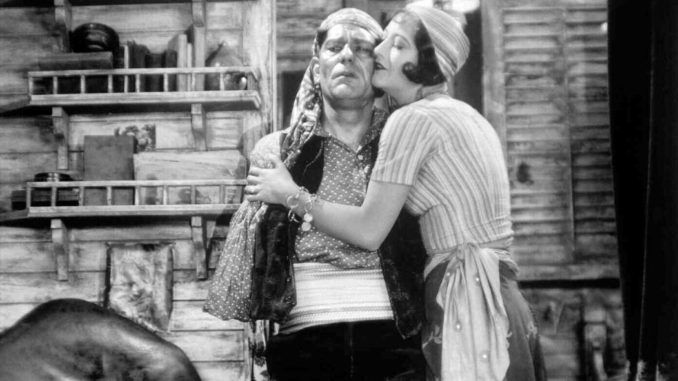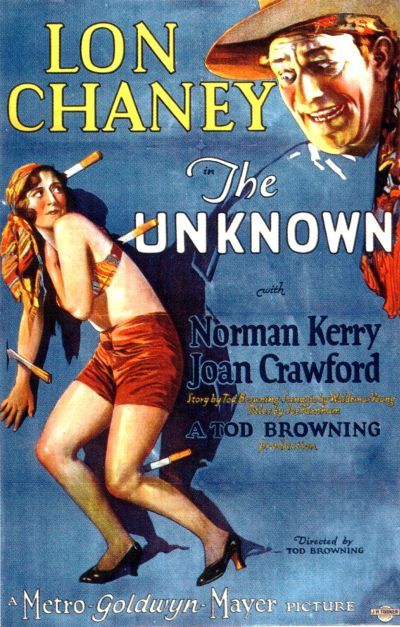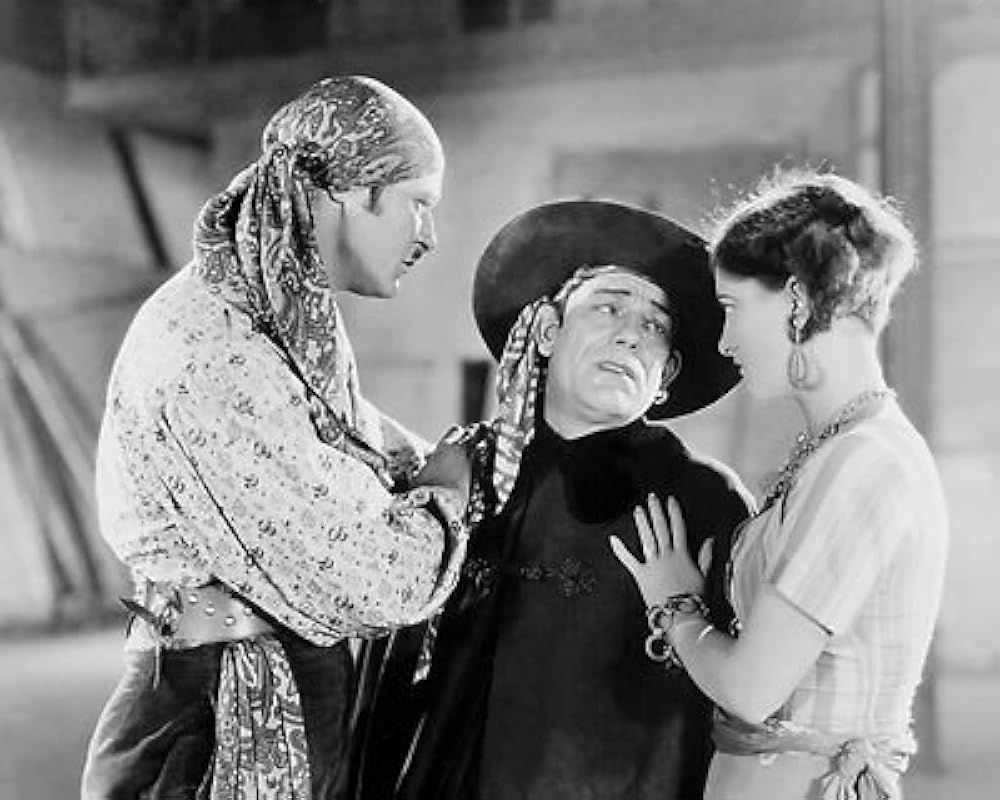
Rating: B
Dir: Tod Browning
Star: Lon Chaney, Norman Kerry, Joan Crawford, Nick De Ruiz
This year is home to the most famous lost film of them all, another Browning and Chaney movie: London After Midnight. It has been gone for sixty years, the last remaining print being destroyed in the disastrous MGM vault fire of 1965. Which does make me wonder how it has over 1,500 ratings on the IMDb. Part of me wanted to write a completely fictitious review of this, just to wind people up. However, that seemed too much like hard work, frankly. Also lost from 1927 is The Wizard, and if you’re not intrigued by the IMDb synopsis, I don’t know what to tell you: “Mad doctor sews human head onto gorilla’s body, Usual catastrophes ensue.”
Seems to have been a year for monkeying around. We got The Gorilla, recently rediscovered, though it’s a mystery comedy. More tempting was probably Curses of the Witch, the first ever Finnish horror(ish) film, which might make into the over-spill article. But in the end, it came down to a choice between this and one of the numerous versions of The Cat and the Canary. With The Unknown having more votes, a higher average rating and feeling more genre appropriate, it wasn’t a difficult decision, although Browning has already had two entries, with Freaks and The Devil-Doll. We’re back to the circus for this: Browning joined one at 16, after running away from home, and spent more than a decade there, turning to movies in his late twenties. It explains the carny atmosphere to a lot of his work.
 This does feel a bit of a dry-run for Freaks, with its twisted story of love and murder beneath the big top. Chaney plays Alonzo the Armless, a performer in the circus capable of doing everything from playing the guitar to throwing knives with his feet. Except, he’s faking it. He straps his arms to his side as a means of avoiding police interest. For he does have a deformity, a double thumb which could be used to link him to various crimes. He also is in love with Nanon (Crawford), the daughter of circus owner Antonio Zanzi (de Ruiz). She has a phobia about being touched, so finds Alonzo’s apparently literal inability to get handsy with her, quite endearing. But he has a rival in Malabar the Mighty (Kerry).
This does feel a bit of a dry-run for Freaks, with its twisted story of love and murder beneath the big top. Chaney plays Alonzo the Armless, a performer in the circus capable of doing everything from playing the guitar to throwing knives with his feet. Except, he’s faking it. He straps his arms to his side as a means of avoiding police interest. For he does have a deformity, a double thumb which could be used to link him to various crimes. He also is in love with Nanon (Crawford), the daughter of circus owner Antonio Zanzi (de Ruiz). She has a phobia about being touched, so finds Alonzo’s apparently literal inability to get handsy with her, quite endearing. But he has a rival in Malabar the Mighty (Kerry).
Things accelerate when the owner discovers Alonzo’s deception, and is strangled with those not-so phantom limbs for his pains during a storm. It’s an incident glimpsed by Nanon, who sees the killer has a deformed thumb. Not knowing Alonzo has a thumb means she can’t identify him as the killer. Alonzo wants to marry her, and comes to the conclusion his arms will be an insurmountable problem. He blackmails a surgeon into removing them permanently – which is both extraordinarily fucked-up, and impressively committed. But while he recuperates, Malabar and Nanon develop a relationship, and Malabar’s proposal of marriage is accepted. Alonzo is not happy to find this out, especially after sacrificing 50% of his limbs. He hatches a plan that is intended to lead to… well, “arms reduction”, let’s put it that way.
It’s another case of a classic movie cramming a lot into a short running-time. The print I saw was less than an hour, though there is a restored 66-minute version with a few additional (though not particularly important) scenes. It’s still fairly disturbing by modern standards. You watch Lon Chaney Jr. pretending to be a cripple – only to discover that his character is also pretending to be a cripple, which is quite the swerve. For Alonzo then to go full method, and have his arms removed for love is shocking: I can’t say the Malabar/Nanno engagement was unexpected though. However, Alonzo then deciding to drag his rival down to the same level of handicap? Well, if that isn’t a metaphor for DEI in action.
Chaney is great. I’m not sure anyone in the silent era is better at conveying emotion through facial expressions. The best scene has him meeting Nanon, who is delighted to see her friend. He mistakes this affection for something deeper, as she excitedly gets ready to break the news of her impending nuptials, unaware it will be a dagger hurled into Alonzo’s heart. And her concern as to whether he has been sick and lost weight – “Yes, about two arms’ worth,” as Chris put it – is the blackest of black comedy. You have to feel for Alonzo, even though over the course of the film, he murders one person, and does his level best to kill another.
 I also want to mention Crawford, who got the role over the studio’s initial choice as Nanon, a fresh bit of Eurototty they had just received called Greta Garbo. Joan was still a teenager at the time, and it’s far and away the earlier entry in her filmography I’ve seen. Despite her enthusiastic whip-cracking at the finale, it feels a completely different role and performance from the ones which would win her acclaim (and an Oscar), later in life. It is a little weird seeing her as an object of desire for the two leads. Though I was also distracted by heartthrob Kerry appearing to have strayed in from The Princess Bride.
I also want to mention Crawford, who got the role over the studio’s initial choice as Nanon, a fresh bit of Eurototty they had just received called Greta Garbo. Joan was still a teenager at the time, and it’s far and away the earlier entry in her filmography I’ve seen. Despite her enthusiastic whip-cracking at the finale, it feels a completely different role and performance from the ones which would win her acclaim (and an Oscar), later in life. It is a little weird seeing her as an object of desire for the two leads. Though I was also distracted by heartthrob Kerry appearing to have strayed in from The Princess Bride.
Got to say, almost none of the above is at all suggested by the poster, or a title which is spectacularly vague. At least Freaks delivers exactly what it says on the label. If I’d been asked to provide a synopsis based on the the advertising, I would have come up with something very different, involving a deranged gaucho who attacks a long-distance swimming competition. Probably no dumber than the plot of The Wizard. Fortunately, Browning is made of sterner stuff, and came up with something genuinely warped. While this may not quite reach the deranged heights from the second half of Freaks, it likely benefits from greater consistency in tone, and definitely a stronger central performance.
This article is part of our October 2025 feature, 31 Days of Vintage Horror.
